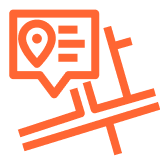In July 2023, Causeway Technologies, a pioneering force in the construction technology landscape, marked a significant milestone by acquiring one.network. This strategic move signifies Causeway’s deepened commitment to enhancing the efficiency, safety, and environmental sustainability of infrastructure construction and maintenance for Departments of Transportation across the United States.
A Legacy of Innovation:
For over two decades, Causeway has been at the forefront of digitally transforming the construction industry, fostering connections among infrastructure owners, contractors, and their supply chains. This has unlocked remarkable efficiencies and contributed to reducing the environmental impact of construction activities. The acquisition of one.network, alongside Causeway’s recent acquisition of Yotta in 2022 and both ReferencePoint and one.network in 2023, underscores a clear vision: to create a unified, comprehensive offering that spans the entire lifecycle of Department of Transportation, Public Works teams, and utility company projects.
Enhancing Highway Infrastructure Management:
The integration of one.network into Causeway’s portfolio is a strategic complement to Causeway’s existing capabilities. one.network’s expertise in providing digital solutions for traffic management, permitting, and real-time communication dovetails with Causeway’s strength in construction supply chain management and contractor/workforce management. This synergy is poised to deliver unparalleled value to Departments of Transportation like the Florida DOT, enabling them to plan, monitor, and communicate the management and maintenance of their assets more effectively.
A United Front for the Future:
Combining solutions with Causeway offers an exciting road to bring additional innovation and value to our customers in the United States. Now, Causeway one.network, is positioned to explore new opportunities, deliver enhanced solutions, and address a broader range of use cases across the US market.
Rest assured, our existing team you’ve come to know and trust remains intact, dedicated to delivering the high standards of service you expect. While you may have noticed some branding changes as we integrate into the Causeway family, our core mission and commitment to our customers remain steadfast. We’re not just expanding our capabilities; we’re amplifying our ability to serve you better, backed by the strength and resources of Causeway Technologies.
What This Means for Our Customers:
This union brings forth a wealth of opportunities for our customers in the US. By tapping into Causeway’s comprehensive suite of solutions, we’re equipped to offer more holistic and integrated services that address the unique challenges of managing and maintaining roadway infrastructure. Our collaboration with entities at every level in Florida – from FDOT to Hillsborough County and the City of Altamonte Springs – exemplifies the depth and breadth of our commitment to enhancing road safety and efficiency through digital innovation, and we are only getting started.
As we embark on this new chapter with Causeway, we invite you to stay tuned for exciting updates and developments. Together, we’re set to redefine what’s possible in the realm of roadway management, ushering in a new era of efficiency, safety, and sustainability.
In a groundbreaking move, Umatilla County has partnered with one.network and Drivewyze to enhance road safety and efficiency across its transportation network. This partnership represents a significant leap forward in the endeavor to modernize roadway and work zone management, promising to set new benchmarks for safe and efficient transport.
“For the first time in the U.S., road crews will be able to communicate directly with truckers through our Live Link app, relaying comprehensive, timely, and vetted work zone information via Drivewyze’s Smart Roadways software. This ensures that freight operators are equipped with the most accurate information, delivered when and how they need it most.”
Simon Topp, Chief Commercial Officer
Highlights of the Partnership:
- Real-Time Incident Notifications: Umatilla County can now provide instant alerts for various incidents, including accidents, road closures, and other disruptions. This feature is crucial for timely communication to both authorities and the public.
Work Zone Safety Enhancement: The partnership emphasizes work zone safety and enables automated notifications about ongoing construction activities and lane closures. This effort is geared toward minimizing inconvenience for commuters and enhancing safety for workers. - Weather-Related Closures Alerts: Integration with meteorological data sources allows the system to issue alerts for adverse weather conditions, leading to more effective management of road safety during challenging weather scenarios.
Emergency Notifications Capabilities: The platform facilitates swift communication during emergencies and natural disasters, ensuring that relevant stakeholders are informed promptly. - Comprehensive Data Integration: The partnership leverages Geographic Information System (GIS) integration to visualize incidents and closures on maps, offering a clear overview for better decision-making.
Pilot Program Scope and Deliverables:
This six-month pilot program is centered on showcasing the effectiveness and benefits of both one.network and DriveWyze’s industry-leading technology. This pilot program is designed to comprehensively implement one.network’s Traffic Management planning and communication tool across Umatilla County. This strategic implementation is aimed at optimizing traffic management and enhancing communication capabilities for road events. Additionally, the deployment of one.network’s Live Link application is a pivotal aspect of this program, offering real-time updates on road closures, thereby significantly improving responsiveness and situational awareness. Furthermore, the program incorporates Drivewyze’s dynamic alert system, which is instrumental in providing timely and accurate notifications for active work zones and closures. This multifaceted approach in the pilot program is set to transform the management and safety of Umatilla County’s transportation network.
Anticipated Outcomes for Umatilla County:
- Enhanced Road Safety: The initiative significantly reduces accidents and fatalities by proactively identifying and mitigating potential safety hazards.
- Operational Efficiency: Improved traffic flow and optimized routes lead to reduced operational costs and increased efficiency for transportation stakeholders.
- Data-Driven Decision Making: Access to comprehensive data analytics empowers decision-makers with valuable insights, facilitating strategic planning and policy formulation.
A Vision for the Future:
“Rural road safety begins with robust, actionable data. There was no pre-existing model for us to emulate that could meet our unique needs for both safety and transportation efficiency. Thanks to this partnership, we’re now turning our vision of digitizing rural roads for the 21st century into reality, setting a precedent for rural communities nationwide.”
Dan Dorran, Umatilla County Commissioner
This partnership is more than just an advancement in technology; it is a commitment to the safety and efficiency of transportation in Umatilla County and a beacon for similar rural communities across the nation. With this initiative, Umatilla County is not only enhancing the safety and efficiency of its own roads but is also laying down a blueprint for the future of rural road management.
For more information on this pioneering initiative, please visit one.network or contact Kieran Holloway.
The recent webinar on Roads and Bridges featuring Olivia Townsend, State Construction Specialty Engineer at the Florida Department of Transportation (FDOT), provided an illuminating insight into their innovative Lane Closure Notification System (LCNS). Powered by one.network, this system represents a significant leap in real-time traffic management and work zone safety.
Background of the Lane Closure Notification System
The LCNS started in June 2022 as a one-year pilot project and transitioned into a multi-year asset to Florida’s work zone safety vision. By August 2023, its success led to a contract renewal. The system primarily aims to communicate lane closure information to motorists via navigation applications like Google Maps and Waze. Its key benefits include:
- Enhanced worker and motorist safety through advanced driver alerts.
- Decreased congestion by offering alternate route options.
- Improved travel time reliability.
The Process and Workflow
The LCNS operates by deploying roadside mobile applications, such as one.network, as well as smart work zone devices. This data is then aggregated inside of one.network and pushed to navigation providers, updating drivers in near real-time.
FDOT’s approach to implementing LCNS involved:
- Intensive Training for Teams: FDOT and one.network implemented comprehensive training for Construction, Engineering, and Inspection (CEI) teams and worksite supervisors, ensuring they were well-versed in the new system’s functionalities and responsibilities.
- User Access Management Coordination: A collaborative effort between district construction offices and state construction support was established to manage user access effectively, streamlining the workflow.
- Real-Time Data Entry and Verification: Utilizing one.network’s smartphone application, worksite supervisors could input lane closures/openings in real-time. These entries were then transmitted to navigation providers within a remarkable five-minute window and immediately visible for CEIs to review in the one.network web app.
- Robust Training and Enforcement Strategy: To guarantee the successful adoption of the system, FDOT and one.network conducted extensive outreach, offering both live, virtual and on-demand training sessions. This initiative emphasized the critical roles and responsibilities of all involved, focusing on realistic data quality reviews to maintain the accuracy and timeliness of lane closure information.
Wins and lessons from FDOT’s LCNS Performance:
- Processed 16,366 closures by June 2023.
- 99% of closures were confirmed and transmitted to navigation providers.
- 87% of closures closed within five minutes of the reported start time.
- Over 50% of closures reopened using the one.network application.
A critical takeaway from the LCNS project is the necessity of early contractor adoption and coordination. This step proved essential for the system’s initial success, ensuring smooth integration and compliance. Equally important was the focus on data quality, particularly in providing realistic reviews of lane closure geometry and timings. These elements were pivotal in maintaining the system’s accuracy and reliability, key to its effectiveness and efficiency.
one.network’s Role: Live Link and Traffic Management
one. network’s Live Link and Traffic Management applications are vital in this project. Live Link facilitated the real-time communication of lane closures directly to navigation providers, while Traffic Management provided a comprehensive platform for managing these closures with accurate and timely data. This integration of one.network’s solutions into FDOT’s workflow exemplify the potential of digital traffic management tools in enhancing road safety and efficiency.
Impact and Moving Forward
Preliminary data suggests a downward trend in work zone-related crashes, highlighting the system’s positive impact. FDOT’s collaboration with one.network demonstrates the power of digital solutions in transforming road safety and traffic management.
As other states and regions seek to improve their traffic management systems, FDOT’s successful implementation of the LCNS serves as a benchmark. It’s a testament to the power of innovative technology like one.network’s solutions in making our roads safer and more efficient.
FDOT’s webinar with Roads and Bridges provided more than just a glimpse into a successful project; it offered a roadmap for future innovations in traffic management. With tools like one.network’s Live Link and Traffic Management, the possibilities for enhancing road safety and efficiency are boundless.
Are you ready to explore how one.network’s solutions can transform traffic management in your region? Schedule a meeting with us and join the journey towards safer, smarter, and more connected roadways.
The Florida Department of Transportation (FDOT) has taken a monumental step forward in ensuring road safety by entering a multi-year collaboration with one.network. This partnership marks a significant advancement in work zone safety, with FDOT solidifying its commitment through our technology. Simon Topp, Chief Commercial Officer of one.network, recognizes this partnership as a critical validation of their platform. Topp expresses enthusiasm for the continuation of this partnership, noting the importance of reversing the increasing trend of work zone fatalities.
Overview of the Program
This extended collaboration builds upon the one-year pilot program’s success, which saw extensive training and deployment efforts. Over 2,000 FDOT employees and construction workers were trained to effectively utilize one.network’s Live Link solution. This training led to the mapping and publication of over 16,600 lane closures throughout all FDOT districts. This initiative stands as the first statewide deployment of worker-managed safety information sharing in the United States, showcasing an innovative approach to work zone safety.
Why It’s Important
The partnership’s core, the Live Link technology, empowers workers to share critical lane and road closure information with major navigation providers directly from the work zone. This facilitates enhanced real-time awareness among drivers, significantly improving safety conditions. The one.network platform complements this by providing a comprehensive, map-based overview of ongoing work zones, integrating live data for improved situational awareness and decision-making.
Impact and Future Vision
FDOT’s commitment, coupled with one.network’s cutting-edge solutions, aims to address the alarming statistic of over 954 annual work zone fatalities in the U.S. The Lane Closure Notification System (LCNS) powered by Live Link is a game-changer in improving driver awareness. It provides critical information at the most impactful moment, thereby enhancing road safety. The success of the pilot has already piqued the interest of other major agencies, such as the Tampa Hillsborough Expressway Authority (THEA), indicating the system’s potential for broader implementation.
Simon Topp underlines the significance of this partnership, emphasizing that the Live Link system managed by the workers themselves is a powerful tool for improving safety in work zones.
“This collaboration is not just about introducing a new technology; it’s a commitment to transforming how work zone safety is managed across the U.S.“
This groundbreaking initiative between FDOT and one.network is poised to revolutionize work zone safety management. As this partnership continues to evolve, it promises a safer future for U.S. roadways, combining innovative technology with an unwavering commitment to saving lives.
In the heart of Arizona, particularly in Maricopa County, the grim rise in crash fatalities, from 606 to 621 between 2021 and 2022, starkly highlights an urgent need for a revamped approach to road safety. With the county shouldering a staggering cost of $12.2 billion due to road crashes, traditional methods must catch up despite their best intentions.
The Current Landscape:
Arizona’s current strategy, heavily reliant on mass media campaigns with an expenditure of $1.5 million, aims to alter driver behavior through emotional and informational messaging. However, as crash statistics grimly climb, it’s evident that a fresh, more impactful approach is necessary. A new survey that shows 97% of highway workers think work zones are more dangerous than last year.
The Data Dilemma:
Many Department of Transportation (DOT) agencies believe they provide real-time work zone updates to navigation providers. The truth, however, is less optimistic. While data is published to Work Zone Data Exchange (WZDx) feeds, the quality often fails to meet the stringent requirements of commercial navigation providers. Without a close-knit relationship with navigation providers to help ensure the data is up to their evolving standard, the result is a communication gap – critical updates not reaching drivers. The data often lacks sufficient GIS geometry, is tethered to outdated plans, and doesn’t reflect live, on-field changes.
The one.network Solution:
Enter one.network, already empowering Florida’s DOT with a successful lane closure system. We propose a similar transformative approach for Arizona, focusing on real-time, accurate, and comprehensive data communication.
GIS Geometry – The Crux of Accurate Data:
The key lies in the shift from single-point to multi-point GIS geometry. That reflects the details of planned work data and can show live data to drivers through navigation providers within minutes. This shift ensures that data is accurate and rich in detail, enabling navigation apps to guide drivers more effectively and safely around work zones.
Benefits of one.network:
- Comprehensive Safety and Communication: At one.network, we are revolutionizing road safety by enabling digital communication for all stakeholders, including internal teams, emergency services, drivers, utilities, contractors, and more. The platform can significantly reduce accident risks by sharing detailed work zone locations and crew presence with drivers through navigation providers. This is achieved by directing drivers to alternate routes or by enhancing on-road safety measures such as alerting drivers to temporary speed limits and worker presence. Live Link plays a crucial role here, ensuring all communicated data is current and accurate, which is pivotal in dynamic work zone environments for timely and reliable information flow. This comprehensive approach to safety and communication not only boosts safety for road workers and drivers but also ensures seamless information sharing across varied stakeholders.
- Strategic Traffic Management and Influence: The one.network approach to Real-time data, comprehensive communication, and strategic traffic management pave the way for safer, more efficient roadways. is a game-changer, fostering efficient interagency cooperation and shared operational views across teams. This shared perspective allows for managing detours across jurisdictions effectively, detecting and mitigating conflicts, and facilitating seamless collaboration. These capabilities are vital in areas with multiple ongoing projects, as they ensure streamlined traffic management and reduce operational complexities. By digitizing work zone plans and permits, one.network offers a fully auditable workflow process, integrating situational awareness and automating document management. This strategic approach not only simplifies the planning process but also enhances coordination, making it a pivotal tool for modern traffic management.
- Reliable Data Integration and Partnerships: A strength of one.network is in our robust relationships with navigation providers, which is integral for ensuring data integrity and reliability for safe and efficient road management. These trusted partnerships allow for seamless integration of diverse data sources, rendering the information accessible and actionable for various stakeholders. In addition to harmonizing data from multiple platforms, our platform also enables analysis of historical traffic trends, real-time traffic monitoring at work zones, management of congestion around work zones, and leveraging insights to optimize planning. This comprehensive approach ensures that all parties in traffic management and road safety work with the most current and accurate information, thereby enhancing overall road operation efficiency and providing a holistic solution for traffic and work zone management challenges.
Impact on Arizona:
By adopting one.network’s solution, Arizona can expect a decline in work zone incidents, a more informed driving public, and a significant step towards Vision Zero. The approach focuses on enhanced safety and paves the way for more efficient use of state funds, redirecting resources from costly media campaigns to impactful, data-driven safety measures.
It’s time for Arizona, a state known for its innovation, to lead the way in road safety. With one. network’s proven solutions, we can turn the tide on road safety, transforming Maricopa County into an efficient, data-driven traffic management model.
Are you ready to take road safety in Arizona to the next level? Schedule a meeting with one.network and embark on a journey towards more secure, intelligent, and connected roadways.
Dallas-Fort Worth (DFW), a titan in American metropolitan regions, has been breaking records for its astounding growth trajectory. Since 2020, the DFW population has grown by nearly 300,000 people. That is almost 1.4% population growth year over year. With such rapid urban expansion comes inevitable urban development and transportation challenges.
Steering Through the Roadwork Labyrinth
Road construction is predominantly a product of the increasing population and traffic demands and re constant fixtures across DFW’s thoroughfares. The steady hum of construction activities is hard to ignore as highways expand and bridges undergo transformation.
However, the sheer volume of construction and its state of variability poses a significant challenge. Projects often run on extended timelines, causing traffic disruptions, which, in turn, demands astute right-of-way management. Effective navigation through this maze requires real-time, precise, and comprehensive data.
Enter the issue of data integrity. Most states, in their pursuit of efficient road management, gather tons of traffic and work zone data. This data, intended to serve as a guiding beacon for navigation providers and end-users, is often collected in formats that need more uniformity. When such fragmented and inconsistent data is channeled into WZDx feeds for broader dissemination, it lacks quality, making it impossible for navigation providers to use. Therefore, updates and real-time information never get to the end user.
To contextualize, data suggests that work zone-related disruptions and miscommunications could contribute to road safety concerns, elongating commutes, and inflating costs. A particularly alarming statistic from TxDOT in 2021 underscores the severity of the issue: deadly crashes in work zones have surged by 33%, resulting in 2,144 fatalities. The urgency for crystal-clear communication has never been higher.
The one.network Proposition: Meeting Modern User Expectations
It’s precisely in serving this need, that one.network positions itself as a trailblazer. Our platform, fine-tuned for metropolitan challenges like those seen in DFW, brings clarity amidst chaos. With our commitment to clear, coherent and actionable data, it’s no wonder that leading navigation providers consistently prefer and trust our data for its reliability.
But what does this mean for the everyday road user in DFW? For starters, it translates to a seamless and predictable commuting experience. Whether it’s a daily drive to work, a trip to the city’s cultural hotspots, or navigation through the labyrinth of construction, one.network ensures that residents and visitors alike are equipped with the most accurate road information available through whichever app or system they use and trust, whether that is Apple Maps, Google Maps, Waze, TomTom or Here Technologies.
Furthermore, the platform empowers decision-makers. For public works teams, contractors, and event organizers, one.network offers a collaborative ecosystem. Here, stakeholders can view, share, and align their projects in real time, reducing the overlap of activities and ensuring smoother project execution.
As we gaze at the horizon of urban development in the U.S., it’s evident that the challenges DFW grapples with will become commonplace in other rapidly growing regions. The imperative for accurate, reliable, real-time roadwork data will only intensify. Cities that wish to stay ahead of the curve must harness platforms like one.network to ensure their infrastructure keeps pace with their growth ambitions.
Dallas-Fort Worth stands as a compelling example for all cities on a journey of expansion and evolution. In the balance of growth and efficient infrastructure management lies the promise of a city that’s not just large but also smart, agile, and responsive.
Now, with one.network championing precise right-of-way management, the future of urban commuting looks not just promising but exhilarating. Get in touch to learn more.Unlock the potential of DFW’s urban growth with one.network’s precise roadwork data. Seamlessly navigate construction, reduce disruptions
Traffic management in metropolitan areas is a blend of complex problems. While daily commutes and routine traffic patterns present their own challenges, special events and work zones introduce layers of unpredictability and potential hazards. For instance, Atlanta, like many bustling urban hubs, faces these issues head-on. But what exactly are the pain points, and how can they be addressed?
Navigating the Work Zone Maze
Work zones are crucial for maintaining and upgrading our infrastructure. Yet, they come with unique challenges, particularly regarding communication and dynamic changes.
Cross-Agency Communication: All too often agencies launch traffic projects, only to find another transportation agency working a few miles away, using the area they have closed off as a detour for their own project. Such overlaps can result from communication delays between traffic agencies and contractors. When real-time, clear communication isn’t facilitated, inefficiencies occur.
Dynamic Changes: As any public works manager knows, the state of a work zone can change by the hour. One second, a lane might be closed. The next, it might be open, but with a diversion further down. This often leads to permits that show a project that lasts three weeks when, in reality, it is a one-day job. This dynamism can be a nightmare for regular commuters if not communicated effectively.
For example, the NHTSA reported an estimated that over 105,000 crashes occurred in work zones in 2021, representing an increase of almost 4000 from 2020. This uptick underscores the importance of effective communication and clear signage.
Public Engagement: Keeping the public in the loop is easier said than done. While agencies might share work zone notifications on their website or via 511, not everyone will be reached by these dated communication methods. Modern problems require modern solutions that bring the information to where the audience is: on their smartphone.
Handling The Surge of Special Event Traffic
Every year, special events in cities such as Atlanta draw millions of attendees traveling from near and far. While such events are a boom for the local economy, they can wreak havoc on traffic patterns.
Imagine an Atlanta Falcons game at Mercedes-Benz Stadium or your local NFL team, with thousands of fans driving to the venue. Without effective traffic management strategies, the result can be gridlock. Additionally, unexpected road closures or diversions due to work zones can exacerbate the situation, leading to increased travel times and frustrated fans.
The one.network Solution
Addressing these challenges requires a holistic approach, blending advanced technology, cross-agency communication, and proactive planning with the ability to communicate changes fast. This is where one.network shines.
Real-time Interagency Updates: One of the cornerstones of effective traffic management is providing real-time information. With one.network, traffic agencies and contractors can offer up-to-the-minute updates about work zones. By having a single source of unified data, agencies will be able to route traffic holistically, regardless of whether they are a state, county or city DOT. This ensures that everyone, from daily commuters to truck drivers, knows what to expect on the roads.
Digital Communication Platforms: Gone are the days of relying solely on radios or newspaper notifications. one.network provides a digital platform that bridges the communication gap between agencies, contractors, and the public. With direct relationships with GPS providers, one.network facilitates seamless interaction and real-time notifications, overlapping schedules, and unexpected roadblocks become a thing of the past.
Special Event Traffic Management: Through cross-agency communication provided by the one.network platform, traffic engineers can predict traffic surges related to special events and implement effective management strategies in real-time. By analyzing past events and current road conditions, agencies can be better prepared to handle the influx, ensuring smooth traffic flow and having the traffic changes reflected on the end user’s GPS.
While challenges abound in managing work zones and special event traffic, they are manageable with the right tools like those provided by one.network. With digital solutions, cities like Atlanta can ensure safer, more efficient roads, regardless of the day’s challenges. Traffic management, when done right, can lead to happier commuters, safer work zones, and successful events. It’s time to embrace the digital age of traffic management.
Ready to streamline your city’s traffic management?
Take the first step towards a smarter, safer, and more efficient transportation network. Connect with our team to explore one.network’s solutions tailored for your city’s needs.
The ITS California Annual Meeting never disappoints, and this year was no exception. The event brimmed with insight, provoking discussions, and a collective push towards a safer and more efficient transportation future. As we reflect on the salient issues addressed, one key takeaway stands out: the desperate need for connected work zones. one.network is uniquely poised to provide the solution.
Key Issues Raised at ITS California:
Data Trustworthiness: Shailen Bhatt, the Head of FHWA, emphasized, “Don’t believe the quality of your data – Test it.” This raises an essential point about ensuring the accuracy, relevance, and timeliness of your traffic and work zone data. This is a serious consideration as agencies try to integrate with the likes of Apple and Google. If road event data is not carefully managed, ensuring it is current with accurate geometries, navigation providers will not use it. It’s as simple as that.
Speedy Implementation Over Perfection: Ted Bailey from WSDOT shared a compelling perspective, stating, “Why pilot in one spot, to notify one work zone, when we can implement a state-wide solution in less than a week and save lives.” His message was clear: The quest for perfection shouldn’t hinder swift actions that can save lives.
Work Zone Safety: With a shocking 43k road-related deaths a year and increasing pedestrian deaths in work zones, David Lucas of Maricopa County encapsulated the need for urgent action, “We have the tools and the tech, but we need the impetus to deploy these solutions.”
one.network is here to help:
Reliable, Real-Time Data: one.network understands the vital need for accurate data. With one.network’s Live Link, your organization can improve the visibility of changing work zone conditions by flagging when workers are present and setting temporary speed limits associated with the lane closure.
Rapid Deployment: As emphasized by Ted Bailey, swift action is critical. one.network’s solutions are not just about quick deployment but also scalability. When nearly 118 people lose their lives on roadways in the United States per day, time matters more than ever. one.network can quickly implement solutions at any level from county municipalities to state-wide deployments like with the Florida Department of Transportation.
Integrated Work Zone Safety: The one.network platform presents a single, intuitive interface designed to drive efficiencies across departments. Input, aggregate and visualize all road incidents, work zones and events within one operational view, and publish to publicly available web maps and navigation providers via WZDx compliant APIs.
ITS California underscored a critical message: our roads need urgent action, not just intention. Quality data for the likes of Apple and Google? Essential. But as Ted Bailey reminded us, speed in action can save lives. With 43k annual road deaths, the stakes are sky-high. one.network isn’t just offering solutions; they’re revolutionizing the game – quickly, smartly, and safely. The future? It’s clear. We need more than tools; we need transformative change. With one.network leading the way, let’s drive into a safer tomorrow.
one.network, a leading road management and work zone data technology provider, today announced the company will be working with the Central Florida Expressway Authority (CFX) to create a Lane Closure Notification System (LCNS) pilot project for the area’s toll roads. CFX’s roads include some of the world’s busiest tourist corridors. The new LCNS, powered by the one.network solution, will allow CFX to communicate roadway disruptions to the public and other stakeholders, improving the safety and efficiency of the network.
The project will include one.network’s mapping, traffic management, permitting and real-time work zone notification software that will provide traffic engineers with a single operational view of all lane closures, as well as maintenance and construction activities throughout the entire CFX network. This LCNS pilot program will last nine months.
“We’re thrilled to be collaborating with CFX, an innovative agency that serves one of the greatest tourist destinations in the world. We’re delivering timely work zone and lane closure information into cars and onto drivers’ devices when they need it most. It adds a critical layer of safety, not only for crews in work zones, but also for drivers who are navigating roads they’ve never seen before.”
James Harris, Founder and Chief Executive Officer, one.network
The LCNS pilot will utilize one.network’s Live Link smart phone app that gives workers the ability to geometrically map out lane closures for each work zone, and with the push of a button, close and open the lanes right from the roadside in near real-time. Through Live Link’s digital updates, workers can deliver information to the one.network solution including whether workers are present and any change in speed limits associated with the closure. The information is then provided directly to GPS companies so they can update their maps for the safety and planning benefit of the driving public.
To help streamline maintenance and construction communications processes, CFX will be one of the first agencies in the country to utilize one.network’s Plan Share platform that eliminates the need for spread sheets and emails to track agency lane closure requests. Plan Share gives internal teams and third parties, including utility companies and other agencies, the ability to create, manage and submit permit applications and project documentation through one.network. Plan Share will empower CFX to coordinate all roadway disruptions and know precisely when projects are scheduled to begin and end, avoiding potential conflicts that could contribute to congestion or create safety issues. Used in conjunction with the Live Link app, it will give traffic managers a big picture view of authorized roadway work, with the ability to verify the accuracy of lane closures and openings in near real-time.
As part of the agreement, one.network will also create a Work Zone Data Exchange (WZDx) feed that can be input into CFX’s advanced traffic management system (ATMS) to provide closure data for added situational awareness on the roadway. CFX’s Intelligent Transportation Systems (ITS) team will be able to use this data over time to analyze traffic patterns and other roadway impacts for future planning and traffic management purposes.
“Using data and technology is the key to reducing congestion on our roadway and improving the quality of life that we’re all desperately seeking.”
James Harris, Founder and Chief Executive Officer, one.network
For more information on one.network and its solutions, or to sign up for email alerts, please click here.
This month, we’re bringing you a major improvement to how work zone and road event information is presented on the one.network map. We’re making it easier and faster for operational users, stakeholders and the public to use the map and access the information they need.
Instead of work zone information appearing in a ‘callout’ box next to the icon, it will now display on the left-hand toolbar, providing more space for content and a smoother map experience.
This will make coordination simpler and more efficient, allowing you to see all the surrounding and relevant road events more clearly.
Below we go into further detail about the key changes.
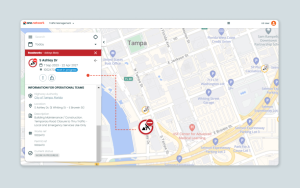
With this new layout, road event data now displays more clearly and includes standardized icons for causes and traffic restrictions, enabling faster and easier retrieval of information.
All sharing and communication options are now located under the three dots button. By clicking this, you will be able to copy and share a link to that individual road event on the one.network map via Facebook, X, or email.
The three dots button also provides the option to ‘Set map date range’ which automatically sets the date range on the one.network map to the same dates specified on the road event callout you have selected.*
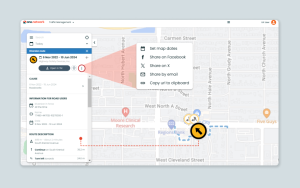
*A quick reminder! You can also set the map date range to match the road event selected by simply clicking on the calendar icon at the top of the ‘callout’.
Next is the new ‘Center on Map’ button. If you open a callout for a road event on the one.network map but then navigate away from the area, you can now click this button to be brought directly back to the location of the road event.
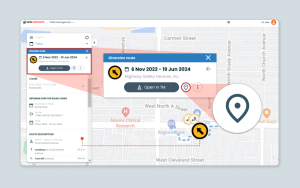
For customers of our Traffic Management module, we’re also excited to introduce a new ‘Traffic Management’ button on the ‘callout’, providing even quicker access to our work zone and traffic management planning tool.
This button will appear at the top of the ‘callout’ whenever you click on a traffic management plan, such as a detour or road closure.
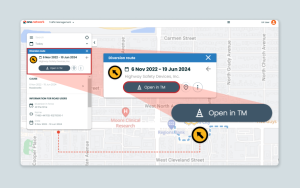
More key improvements to one.network callouts:
Identifying which closures and detours are associated with which work zones is now simpler than ever before. When opening a road event ‘callout’, any related road closures and detours will now be highlighted on both the ‘callout’ and on the map. This will be the case regardless of which layers you have enabled and what zoom level you are at.
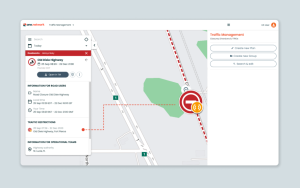
Hovering over a road event on the one.network map will now show useful and relevant information, reducing the need to click and saving you time when searching the map. The data displayed includes dates, works status*, responsible promoters, reference numbers and more.
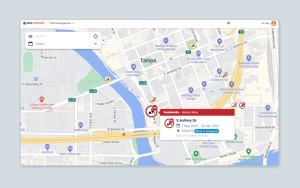
*Work Status will display whether the works are about to start, in progress, completed or cancelled. It will also highlight where works are ‘Forward Planning’ or ‘Advanced Planning’.
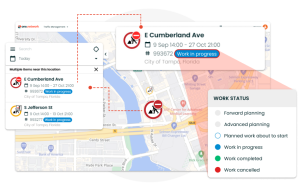
Clicking on a cluster of road events on the one.network map will show a list of the road events in the left-hand panel along with useful and relevant data about each event, again reducing the need to click for more information.
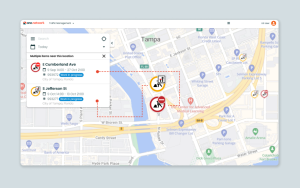
The new addition of a ‘Back’ button will now allow you to skip back to the ‘callout’ for the previous road event you clicked on.
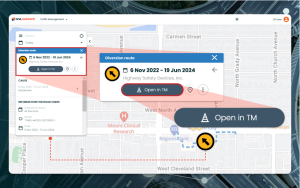
- Once a road event icon has been clicked, the ‘callout’ will stay open and visible irrespective of the map’s zoom level.
- Hovering over icons or lines on the one.network map will bolden and highlight the icon or line, making it easier to identify specific items on the map. The same applies to ‘Causes’ and ‘Traffic Restrictions’ listed on callouts.
If you have any questions on anything included in this release, please contact help@one.network.
